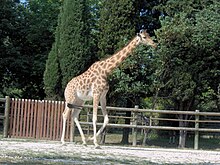Kordofan giraffe
| Kordofan giraffe | |
|---|---|

| |
| Kordofan giraffe in Vincennes Zoo, Paris | |
| Scientific classification | |
| Kingdom: | Animalia |
| Phylum: | Chordata |
| Class: | Mammalia |
| Order: | Artiodactyla |
| Family: | Giraffidae |
| Genus: | Giraffa |
| Species: | G. camelopardalis
|
| Subspecies: | G. c. antiquorum
|
| Trinomial name | |
| Giraffa camelopardalis antiquorum | |

| |
| Range map in teal | |
The Kordofan giraffe (Giraffa camelopardalis antiquorum) is a subspecies of giraffe found in northern Cameroon, southern Chad, Central African Republic and possibly western Sudan.[2] Historically some confusion has existed over the exact range limit of this subspecies compared to the West African giraffe, with populations in e.g. northern Cameroon formerly assigned to the latter.[2] Genetic work has also revealed that all "West African giraffe" in European zoos are in fact Kordofan giraffe.[2] It has been suggested that the Nigerian giraffe's ancestor dispersed from East to North Africa during the Quaternary period and thereafter migrated to its current Sahel distribution in West Africa in response to the development of the Sahara desert.[3] Compared to most other subspecies, the Kordofan giraffe is relatively small at 3.8 to 4.7 meters,[4] with more irregular spots on the inner legs. Its English name is a reference to Kordofan in Sudan.[5][6] There are around 2,000 individuals living in the wild.[7]
The Christian Science Monitor lists only 38 individuals being alive in the embattled Garamba National Park in The Democratic Republic of Congo due to poaching; their skin is used for luxury goods and they are said to produce enough meat to feed poachers for weeks.[citation needed] Recent genetic studies also shows distinct genetic populations of giraffes that makes conservation of these subspecies even more important.[8]
References[]
- ^ Fennessy, J. & Marais, A. (2018). "Giraffa camelopardalis ssp. antiquorum". IUCN Red List of Threatened Species. 2018: e.T88420742A88420817.
- ^ Jump up to: a b c Hassanin, A.; A. Ropiquet; A. L. Gourmand; B. Chardonnet & J. Rigoulet (2007). "Mitochondrial DNA variability in Giraffa camelopardalis: consequences for taxonomy, phylogeography and conservation of giraffes in West and central Africa". Comptes Rendus Biologies. 330 (3): 265–274. doi:10.1016/j.crvi.2007.02.008. ISSN 1631-0691. PMID 17434121.
- ^ D'haen, Mathias; Fennessey, Julian; Stabach, Jared; Brandlova, Karolina (September 2019). "Population structure and spatial ecology of Kordofan giraffe in Garamba National Park, Democratic Republic of Congo". Ecology and Evolution. 9 (19): 11395–11405. doi:10.1002/ece3.5640. PMC 6802069. PMID 31641481 – via Web of Science.
- ^ "Giraffe Species". www.Giraffworlds.com. Retrieved 2018-01-31.
- ^ "Kordofan giraffe". Parc Animalier d'Auvergne. Retrieved 2 December 2020.
- ^ "Keeping up with the Kordofans – a special subspecies of giraffe". Africa Geographic. Retrieved 2 December 2020.
- ^ "Kordofan Giraffe Conservation in Chad". Giraffe Conservation. Retrieved 2 December 2020.
- ^ Hinckley, Story (28 February 2016). "Why is this rare giraffe almost extinct?". The Christian Science Monitor. Retrieved 11 September 2016.
External links[]
 Media related to Kordofan Giraffes at Wikimedia Commons
Media related to Kordofan Giraffes at Wikimedia Commons Data related to Giraffa camelopardalis antiquorum at Wikispecies
Data related to Giraffa camelopardalis antiquorum at Wikispecies
- IUCN Red List critically endangered species
- Giraffes
- Mammals of Chad
- Mammals of the Central African Republic
- Mammals of the Democratic Republic of the Congo
- Mammals of Cameroon
- Even-toed ungulate stubs
